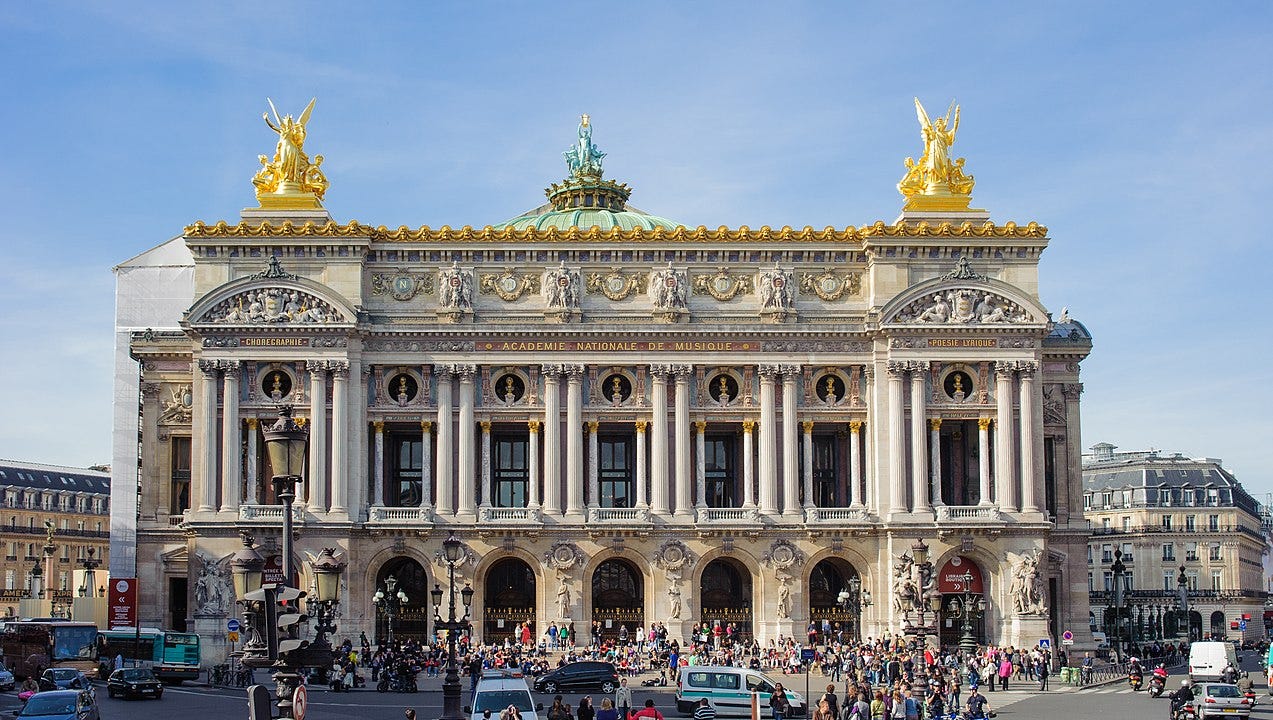Temps Passés: Conceived in empire, birthed in war, the Paris opera house turns 150
Napoleon III made Paris into the grand city we know today, but hubris cost him the crown.
THE GLEAMING AND GILDED old opera house, cathedral to the arts and tourism at the center of downtown Paris, has just turned 150. It was conceived by the last emperor and birthed in a bloody, turbulent period that ended the monarchy in France and witnessed the consolidation of Germany’s small duchies and city-states into the aggressive behemoth of the next century.
Now it is Palais Garnier, or Garnier Palace, after its architect Charles Garnier, a prodigy who won the prestigious Prix de Rome and at age 35 emerged the winner of a design competition. To the disdain of the Empress Eugénie, he vanquished establishment names like Viollet-le-Duc, who only a few years before had completed the restoration of Notre Dame Cathedral. He bought his way back into the empress’s favor by telling her it was designed in “Napoleon III style,” not imported from elsewhere. Experts thought it owed much to Italy.
Photo © Alexander Hoernigk (via Wikimedia Commons)
The last half of the 18th century was precarious in Europe. Napoleon Bonaparte, who conquered much of his continent and others in the years after the French Revolution but failed in Russia, died on St. Helena Island in 1821, when his nephew Charles-Louis Napoleon was a young teen.
Even in his twenties, Louis Napoleon viewed the leadership of France as his destiny and rose to president of the republic, a job limited to one four-year term. Dissatisfied with that limit, he tried to get the Constitution changed but the parliament refused. When he should have left office, he staged a midnight coup and seized power, and a year later made himself Emperor Napoleon III. He began two decades of authoritarian but modernizing rule but came to a hard end.
As emperor, Louis completely reshaped the face of Paris. His prefect, Baron Haussmann, was charged with updating the medieval warren to the handsome city it is today. (The broad avenues, lined with buildings of Haussmann’s original design, offered beauty as well as the advantage of clear lines of fire. Napoleon III was an authoritarian and a military man, although not a very good one. The chaos in neighboring Germany must have been on his mind.)
Garnier was hired to build the world’s most opulent and beautiful opera house at the north end of Avenue de l’Opéra, which ran in a straight line to the Louvre to the south. He stipulated that the Avenue should not be lined with trees, which would impede the view. And so it remains.
He lived at the end of an epoch when emperors were the battlefield leaders of their armies. In 1870, while the opera house was well under construction and under public pressure to respond to border demands from Germany, he declared war on the Prussians and their allied German states. It was an act of blind hubris—the French army folded almost immediately and collapsed two months after the declaration of war at the Battle of Sedan.
His capture by the Prussians effectively ended the Second Empire. He was ransomed, retired to England, and died less than three years later.
The avenue was completed four years after the opera house itself. It replaced a dense, medieval neighborhood of the sort reproduced pretty well in the movie Les Misérables.
The shell of the opera house had been used for storage during the war and the bloody but short-lived Commune. The basement held munitions, which may have given the Communards pause when they considered torching the entire building, so it came through with minor damage. Construction resumed after the Communards were suppressed, very brutally. The first performance was January 5, 1875 — 150 years ago.
Opening night was a gala affair, featuring extracts of opera popular at the time (you may be familiar with some of the composers, but probably not all of them) and the ballet.
Napoleon III never saw the finished product. Charles Garnier went on to design the Opera de Monte-Carlo, two buildings that became theaters in Paris, and several grand private homes. He retired to Provence and died at age 72.
No account of the opera is complete without dealing with a myth or two. Yes, there is a lake under the building, which Garnier designed to handle the unexpectedly high water table. The Paris firemen still use it to practice scuba rescue and other underwater arts.
No, there is no phantom, despite what the famous 1910 novel by Gaston Leroux would have us believe. Or Julian Lloyd Webber, for that matter. Both are terrific entertainment, but not history.
In 1989, the larger Opera Bastille supplanted Palais Garnier as the main home of the Paris Opera. Garner is now used primarily for the opera’s ballet, and for concerts. It has excellent English-language tours.
Links
150 years of the Palais Garnier - Opéra National de Paris (includes the video linked above).




Lovely piece of history, thanks John!
Thank you for the great history lesson! I plan to take an adult group there in March for a tour. I agree - the tours are great there.